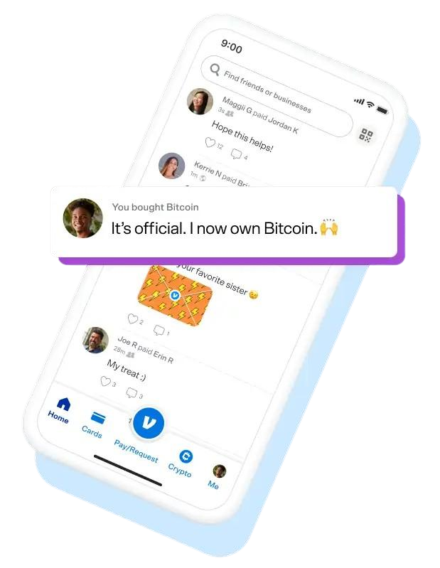
Looking to get your hands on some Bitcoin in 2024 but don’t know where to start? With Venmo’s new crypto on Venmo feature allowing users to buy, hold, and sell cryptocurrency directly within the popular peer-to-peer payment app, getting Bitcoin just became a whole lot easier.
In this quick and easy guide, we’ll walk you through step-by-step how to purchase Bitcoin using one of the most widely used payment apps out there.
What is Venmo?
Venmo isn’t just about splitting dinner bills or paying your roommate for rent; it’s also a platform that lets you venture into the world of cryptocurrencies.
Founded in 2009 and under PayPal’s wing since 2013, Venmo has evolved into a peer-to-peer money transfer powerhouse in the United States.
And now, Venmo has jumped on the cryptocurrency train. They rolled out this feature in April 2021, following in the footsteps of PayPal.
If you’re in the U.S. (excluding Hawaii), you can buy, sell, and hold four cryptocurrencies with Venmo: Bitcoin (BTC), Ethereum (ETH), Litecoin (LTC), and Bitcoin Cash (BCH). They’re even thinking about adding the PayPal USD stablecoin (PYUSD) in the future.
Read also! Cash App vs Venmo: Which Is the Better Choice for Your Digital Payments?
Here’s How to Buy Bitcoin with Venmo

Before showing you how to buy Bitcoin with Venmo, know the following:
- Funding Sources: Venmo lets you use your Venmo balance, linked bank account, or debit card to buy Bitcoin. Keep in mind that credit cards and Venmo Credit Cards aren’t supported.
- Limits: There are some limits to be aware of. You can buy up to $20,000 worth of crypto per week and up to $50,000 per year.
- Exchange Rate: Buying Bitcoin is essentially exchanging your U.S. dollars for digital coins. The exchange rate at the moment determines how much Bitcoin you get, but remember, crypto prices can be as unpredictable as the weather.
That said, let’s walk you through the five simple steps of purchasing Bitcoin with Venmo:
- Open the Venmo app: Fire up your Venmo app and look for the “Crypto” tab at the bottom of your screen.

- Choose Bitcoin: Among the list of cryptocurrencies, select “Bitcoin (BTC).” You’ll also see the current price of Bitcoin right there.
- Click “Buy”: Tap the “Buy” button at the bottom of the page.
- Enter your amount: Now, type in the amount in dollars that you want to convert into Bitcoin. Hit “Review” to double-check all the details, like your bank account, the exchange rate, and the transaction fee.
- Review and Confirm: Venmo will break down how much Bitcoin you’ll get and any associated fees. Once you’re happy with the details, hit “Buy.”

Remember, once you’ve bought Bitcoin through Venmo, it’s a one-way street. You can’t turn it back into dollars within the app. You’ll need to sell it elsewhere if you want to cash out. And don’t forget, the crypto world is like a rollercoaster, so prices can change fast!
You can also check out the video below to learn how to buy Bitcoin with Venmo!
Tracking Your Bitcoin
After you buy Bitcoin with Venmo, you can keep an eye on its price within the app. Venmo even gives you the history of Bitcoin’s prices and past transactions, so you can see how your investment is doing.
To keep an eye on how your Bitcoin investment is doing, take the following 3 simple steps:
- Navigate to the “Crypto” tab: Open the Venmo app and head to the “Crypto” section.
- Select Bitcoin: Find “Bitcoin” on the list of cryptocurrencies.
- Turn on Price Alerts: Activate the Price Alerts toggle. This way, you’ll get notifications if Bitcoin’s price takes a wild ride.
Venmo Bitcoin Fees
When you buy Bitcoin on Venmo, there are two main fees you need to be aware of. First, Venmo charges a 1.5% transaction fee for each Bitcoin purchase you make. This allows them to cover the costs of conducting the transaction on their platform.

Additionally, there is a spread fee that is embedded into the exchange rate shown at the time you place the trade. This is Venmo’s commission; the difference between the market exchange rate and the rate at which they sell you Bitcoin.
Venmo does not charge any deposit fees, monthly account fees or withdrawal fees like some other crypto exchanges. The only fees are the upfront 1.5% transaction fee and spread fee at the time you complete each Bitcoin trade. So it’s actually a very reasonable and competitive fee structure compared to many other crypto on-ramps.
Who Can Buy Bitcoin with Venmo?
To hop on the Bitcoin train with Venmo, here’s the checklist:
- Age: You need to be at least 18 years old.
- Location: You should be physically in the U.S., except for Hawaii.
- Payment methods: You’ll need a Venmo balance, bank account, or a debit card.
- Unique phone number: Your phone number should be unique and not connected to another Venmo account.
And just so you know, you’ll need to verify your identity to use Venmo for cryptocurrencies. That means sharing stuff like your Social Security number or Individual Taxpayer Identification Number. And this crypto feature is for regular folks, not businesses or charities.
And that’s it! As long as you meet these criteria, you can buy Bitcoin with the Venmo app.
Read also! How to Buy and Send Bitcoin on Cash App – A Beginner’s Guide
Price Alerts
Keep an eye on Bitcoin’s ups and downs with Venmo’s Price Alerts. They can help you make informed decisions by sending notifications when the price changes. But remember, don’t rely solely on them for your crypto decisions.
Here’s how to set up Bitcoin Price Alerts:
- Go to the “Crypto” tab: Open Venmo and head to “Crypto.”
- Choose Bitcoin: Find “Bitcoin” in the list.
- Activate Price Alerts: Toggle on Price Alerts and set the desired percentage for price fluctuations.
And that’s it! Now you’re all set to track Bitcoin’s moves in real-time.
Security
Venmo takes security seriously. They use encryption to protect your info and let you log out if you lose your phone. You can even set a PIN for extra safety and enable two-factor authentication.
While Venmo has put stringent security measures in place, it’s important for users to remain vigilant regarding potential risks. These risks, often associated with scams and cybercriminal activities, can have direct consequences for Venmo users. To safeguard your Venmo account, consider the following precautions:
- Protect Your Credentials: Never share your Venmo login details with anyone. Your login credentials are the keys to your financial information, and sharing them could lead to unauthorized access.
- Strong Passwords: Use strong, unique passwords for your Venmo account. This reduces the risk of unauthorized access through password guessing or hacking attempts.
- Privacy Settings: Adjust your account settings to enhance privacy. This includes setting your account to private, limiting who can see your transactions, and controlling the visibility of your financial activity.
- Transaction Transparency: Be aware that Venmo defaults to publicly displaying peer-to-peer transactions, although it doesn’t reveal the transaction amount. While this may not expose sensitive information directly, it’s wise to exercise caution when sharing financial details.
It’s worth noting that in 2018, Venmo entered into an agreement with the Federal Trade Commission (FTC) to address various privacy and security concerns. This resulted in adjustments to the platform’s settings and practices. However, despite these efforts, Venmo has still faced scrutiny for potential privacy vulnerabilities.
Drawbacks
When it comes to purchasing Bitcoin through Venmo, there are several important drawbacks to keep in mind:
- Lack of Purchase Protection: One significant limitation is that Venmo’s Purchase Protection does not cover cryptocurrency purchases. This means that users are not shielded from potential losses resulting from the volatile nature of cryptocurrency prices. Unlike traditional transactions, where you might have recourse in case of problems, Bitcoin transactions on Venmo are irreversible, highlighting the need for careful research and prudent decision-making.
- Limited Insurance: Unlike traditional banks, which often provide insurance through entities like the Federal Deposit Insurance Corporation (FDIC) or the Securities Investor Protection Corporation (SIPC), Venmo’s Bitcoin and investment balances lack this kind of protection. This means that the funds you hold within the Venmo app are not insured in the same way they would be in a bank account. This can be a concern, particularly if you’re considering storing substantial amounts of cryptocurrency on the platform.
- Inability to Transfer: Another drawback is that any cryptocurrency or asset acquired on Venmo remains confined to the platform. In other words, you cannot transfer your crypto to other platforms or personal accounts. This limitation can be restrictive for individuals who prefer to have more control over their cryptocurrency holdings, such as holding them in a secure digital wallet or exploring various trading options on different exchanges.
Conclusion
There you have it – a simple guide to buying Bitcoin with Venmo. While Venmo offers a convenient way to access and invest in Bitcoin, it’s important to be aware of these limitations.
The absence of purchase protection, lack of insurance for your cryptocurrency holdings, and the inability to transfer your assets to other platforms are factors to carefully consider when using Venmo for your cryptocurrency transactions.
As with any investment, it’s crucial to weigh the pros and cons and make informed decisions that align with your financial goals and risk tolerance.
